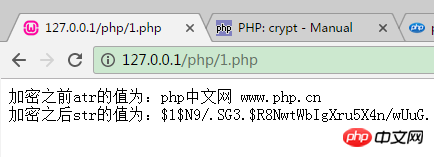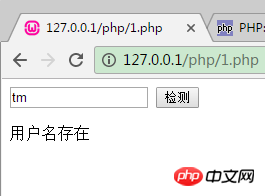 Backend Development
Backend Development
 PHP Tutorial
PHP Tutorial
 PHP encryption function—crypt() function encryption usage example
PHP encryption function—crypt() function encryption usage example
PHP encryption function—crypt() function encryption
Before introducing the encryption function, let us first introduce the principle of data encryption: it is to The file or data is processed according to a certain algorithm, making it an unreadable piece of code, usually called "ciphertext". Through this method, the purpose of protecting the data from illegal theft and reading is achieved!
The functions that can encrypt data in PHP mainly include: crypt(), md5() and sha1(), as well as the encryption extension libraries Mcrpyt and Mash. In this article, we first introduce the use of crpyt() function for encryption!
crypt() function can complete the one-way encryption function, which is a one-way string hash!
crypt() function syntax format is as follows:
string crypt ( string $str [, string $salt ] )
| Algorithm | salt length |
| CRYPT_STD_DES | 2-character (default) |
| CRYPT_EXT_DES | 9-character |
| CRYPT_MD5 | 12-character (starting with $1$) |
| CRYPT_BLOWFISH | 16-character (starting with $2$) |
Here is a note:
By default, PHP uses one or two characters of DES interference string , if the system uses MD5, then 12 characters will be used. You can check the length of the currently used interference string through the CRYPT_SALT_LENGTH variable!
crypt() function instance usage:
Let’s use an example below to make it clear to everyone. The specific code is as follows:
<?php
header("Content-Type:text/html; charset=utf-8");
$atr = "php中文網(wǎng) m.miracleart.cn"; //聲明字符串變量$atr
echo "加密之前atr的值為:".$atr;
$atr1 = crypt($atr); //對(duì)變量$str 加密
echo "<br>加密之后str的值為:".$atr1; //輸出加密后的變量
?>Output The results are as follows:

After executing the above example, keep refreshing the browser, you will find that the encryption results generated each time are different, so how to compare them Judging the encrypted data becomes a problem. The crypt() function is a one-way encryption, the ciphertext cannot be restored to plaintext, and the data after encryption is different each time. This is the problem that the salt parameter is to solve.
The crypt() function uses the salt parameter to encrypt the plaintext. When judging, the output information is encrypted again using the same salt parameter, and the judgment is made by comparing the results after the two encryptions!
The following example checks the input user name. The specific code is as follows:
<?php
header("Content-Type:text/html; charset=utf-8");
$link=mysqli_connect("localhost","root","");
$db_selected = mysqli_select_db($link,"my_db");
?>
<form name="form1" action="" method="post">
<input type="text" name="username" id="username" size="15">
<input type="submit" name="Submit" value="檢測(cè)">
</form>
<?php
if(isset($_POST["username"])!=""){
$usr=crypt(isset($_POST["username"]),"tm"); //對(duì)用戶(hù)名進(jìn)行加密
$sql = "select * from tb_user where user = '".$usr."'";//生成查詢(xún)語(yǔ)句
$rst = mysqli_query($link,$sql); //執(zhí)行語(yǔ)句,返回結(jié)果集
if($rst){
echo "用戶(hù)名存在";
}else{
echo "用戶(hù)名可以使用";
}
}
?>The output result is as follows:

Next article we We will introduce how to use the MD5() function for encryption. For details, please read "PHP Encryption Function—md5() Function Encryption"!
[Related Recommendations]
1. Related topic recommendations: "PHP Encryption Function"
2.PHP Encryption Function—md5() function encryption example usage
3.PHP encryption function—Instance usage of sha1() function encryption
4.PHP encryption technology video tutorial
The above is the detailed content of PHP encryption function—crypt() function encryption usage example. For more information, please follow other related articles on the PHP Chinese website!

Hot AI Tools

Undress AI Tool
Undress images for free

Undresser.AI Undress
AI-powered app for creating realistic nude photos

AI Clothes Remover
Online AI tool for removing clothes from photos.

Clothoff.io
AI clothes remover

Video Face Swap
Swap faces in any video effortlessly with our completely free AI face swap tool!

Hot Article

Hot Tools

Notepad++7.3.1
Easy-to-use and free code editor

SublimeText3 Chinese version
Chinese version, very easy to use

Zend Studio 13.0.1
Powerful PHP integrated development environment

Dreamweaver CS6
Visual web development tools

SublimeText3 Mac version
God-level code editing software (SublimeText3)

Hot Topics
 How to get the current session ID in PHP?
Jul 13, 2025 am 03:02 AM
How to get the current session ID in PHP?
Jul 13, 2025 am 03:02 AM
The method to get the current session ID in PHP is to use the session_id() function, but you must call session_start() to successfully obtain it. 1. Call session_start() to start the session; 2. Use session_id() to read the session ID and output a string similar to abc123def456ghi789; 3. If the return is empty, check whether session_start() is missing, whether the user accesses for the first time, or whether the session is destroyed; 4. The session ID can be used for logging, security verification and cross-request communication, but security needs to be paid attention to. Make sure that the session is correctly enabled and the ID can be obtained successfully.
 PHP get substring from a string
Jul 13, 2025 am 02:59 AM
PHP get substring from a string
Jul 13, 2025 am 02:59 AM
To extract substrings from PHP strings, you can use the substr() function, which is syntax substr(string$string,int$start,?int$length=null), and if the length is not specified, it will be intercepted to the end; when processing multi-byte characters such as Chinese, you should use the mb_substr() function to avoid garbled code; if you need to intercept the string according to a specific separator, you can use exploit() or combine strpos() and substr() to implement it, such as extracting file name extensions or domain names.
 How do you perform unit testing for php code?
Jul 13, 2025 am 02:54 AM
How do you perform unit testing for php code?
Jul 13, 2025 am 02:54 AM
UnittestinginPHPinvolvesverifyingindividualcodeunitslikefunctionsormethodstocatchbugsearlyandensurereliablerefactoring.1)SetupPHPUnitviaComposer,createatestdirectory,andconfigureautoloadandphpunit.xml.2)Writetestcasesfollowingthearrange-act-assertpat
 How to split a string into an array in PHP
Jul 13, 2025 am 02:59 AM
How to split a string into an array in PHP
Jul 13, 2025 am 02:59 AM
In PHP, the most common method is to split the string into an array using the exploit() function. This function divides the string into multiple parts through the specified delimiter and returns an array. The syntax is exploit(separator, string, limit), where separator is the separator, string is the original string, and limit is an optional parameter to control the maximum number of segments. For example $str="apple,banana,orange";$arr=explode(",",$str); The result is ["apple","bana
 JavaScript Data Types: Primitive vs Reference
Jul 13, 2025 am 02:43 AM
JavaScript Data Types: Primitive vs Reference
Jul 13, 2025 am 02:43 AM
JavaScript data types are divided into primitive types and reference types. Primitive types include string, number, boolean, null, undefined, and symbol. The values are immutable and copies are copied when assigning values, so they do not affect each other; reference types such as objects, arrays and functions store memory addresses, and variables pointing to the same object will affect each other. Typeof and instanceof can be used to determine types, but pay attention to the historical issues of typeofnull. Understanding these two types of differences can help write more stable and reliable code.
 Using std::chrono in C
Jul 15, 2025 am 01:30 AM
Using std::chrono in C
Jul 15, 2025 am 01:30 AM
std::chrono is used in C to process time, including obtaining the current time, measuring execution time, operation time point and duration, and formatting analysis time. 1. Use std::chrono::system_clock::now() to obtain the current time, which can be converted into a readable string, but the system clock may not be monotonous; 2. Use std::chrono::steady_clock to measure the execution time to ensure monotony, and convert it into milliseconds, seconds and other units through duration_cast; 3. Time point (time_point) and duration (duration) can be interoperable, but attention should be paid to unit compatibility and clock epoch (epoch)
 How to pass a session variable to another page in PHP?
Jul 13, 2025 am 02:39 AM
How to pass a session variable to another page in PHP?
Jul 13, 2025 am 02:39 AM
In PHP, to pass a session variable to another page, the key is to start the session correctly and use the same $_SESSION key name. 1. Before using session variables for each page, it must be called session_start() and placed in the front of the script; 2. Set session variables such as $_SESSION['username']='JohnDoe' on the first page; 3. After calling session_start() on another page, access the variables through the same key name; 4. Make sure that session_start() is called on each page, avoid outputting content in advance, and check that the session storage path on the server is writable; 5. Use ses
 How does PHP handle Environment Variables?
Jul 14, 2025 am 03:01 AM
How does PHP handle Environment Variables?
Jul 14, 2025 am 03:01 AM
ToaccessenvironmentvariablesinPHP,usegetenv()orthe$_ENVsuperglobal.1.getenv('VAR_NAME')retrievesaspecificvariable.2.$_ENV['VAR_NAME']accessesvariablesifvariables_orderinphp.iniincludes"E".SetvariablesviaCLIwithVAR=valuephpscript.php,inApach





